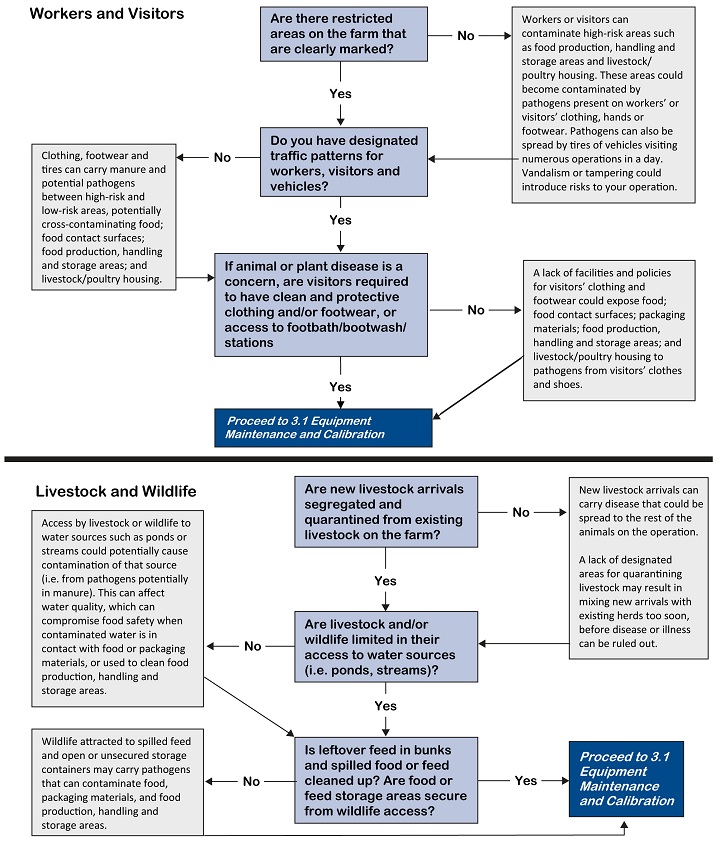Farm buildings and access - 2.5 Access
If visitors, workers, livestock and wildlife have uncontrolled access to or within the farm, contamination can occur in a variety of ways.

This good agricultural practice applies to all farms.
What needs to be done
Control or manage access to or within the farm to reduce contamination.
How to do it
Limit visitor access
- Determine areas of restricted access.
-
Use restricted access signs or have building security, such as locked doors, to prohibit entry.
Establish visitor access practices
Have practices in place for visitors, such as agri-business service providers or tour groups. These practices could include:
- Request visitors to wear clean clothing and footwear
- Use preventative measures (for example, single-use boots, coveralls, boot wash stations or footbaths)
- Designate parking or loading/unloading areas
- Designate traffic patterns for vehicles and visitors
- Provide a visitor log
Protect water and feed sources
- When necessary, limit access to water sources by livestock and wildlife by using deterrents such as fencing or noise bangers
- Drain and clean water troughs regularly to remove livestock manure and bird droppings
- Avoid leftover feed in bunks and clean up spilled feed that may attract wildlife
Reduce the spread of disease
Implement preventative measures to reduce the spread of disease in livestock and poultry. These measures could include:
- Quarantine or separate new arrivals where possible
- Adopt all-in-all-out or staggered starter/grower/finisher management cycles
- Manage worker and livestock movements from high-risk to low-risk areas
- Adopt sanitary measures between high-risk and low-risk areas
If you have an audit
Be prepared for the auditor to:
- Observe restricted access areas and the appropriate signage
- Review visitor access practices and/or a visitor log book
Laws and regulations
There are a number of laws that regulate biosecurity and disease management in agricultural production, but few impact on food safety directly. This section only refers to the control of diseases that may be spread to humans through food consumption. Many animal and plant diseases that are regulated to prevent the spread of diseases to other animals or plants have no impact on food safety to humans.
The Milk Industry Act, R.S.B.C. 1996, c. 289, Milk Industry Standards Regulation, Reg. 464/81 sets out the following requirements that are related to biosecurity:
- S. 14 (2), no animals other than cows or goats are permitted in a milking parlour or milking room or in a building in which is located a milking parlour or milking room
- S. 15, no cattle that are giving bloody, stringy or otherwise abnormal milk or that are being treated with antibiotic or chemotherapeutic agents be included in a milking herd
- S. 30, no animals or fowl shall be permitted to enter a milk house
Important legislation
Ensure any animals received are not prohibited under biosecurity regulations that prohibit or restrict the import of certain live animals under the Health of Animals Act (Canada), 1990, c. 21 and Regulations. For example, these regulations place import restrictions and quarantine requirements on a number of animals, including a prohibition against the import of cattle from non-BSE-free countries, honeybees and other animals
Under the Health of Animals Act (Canada), 1990, c. 21, s. 5 and s. 6, producers who own or have possession, care or control of an animal that has a reportable disease or toxic substance or any fact indicating its presence in or around the animal must notify the nearest veterinary inspector and take samples as required. S. 7 requires that where there exists a disease or toxic substance that is capable of affecting animals, the owner or person in possession, care or control of the animal shall post a notice forbidding entry without the person’s permission. The animal in question may not be put out on unenclosed land; brought to market, fair or other location; sold or transferred without a licence issued by an inspector or officer [s. 9-s. 11]. The Health Act Communicable Disease Regulation, Reg. 4/83, s. 2, schedule A sets out the list of diseases that cannot be concealed and must be reported
See also Food Safety Act, S.B.C. 2002, c. 28, s. 3 and Food and Drugs Act (Canada), R.S., c. F-27, s. 4
